
The HD-2D Remake of Dragon Quest I & II is now available, following the successful release of Dragon Quest III HD-2D Remake last year. I’ve tested this new remake on various platforms – just as I did with Dragon Quest III – to see how well it performs on different hardware. A key difference from the previous remake is that Dragon Quest I & II was released for both the original Switch and the new Switch 2 at the same time. In this article, I’ll share my performance findings for the game on PlayStation 5, Xbox Series X, Steam (played on Steam Deck), Steam (played on ROG Ally), Xbox (Play Anywhere version on ROG Ally), Switch OLED, the original Switch (for backward compatibility), and the native version on the new Switch 2.
If you’re wondering where to play Dragon Quest I & II HD-2D Remake, you’re in the right place! I’ve previously compared versions of other Square Enix games like Triangle Strategy, Final Fantasy IX, the Final Fantasy Pixel Remaster series, and Chrono Trigger, and I’m doing the same here. This guide will help you choose the best platform, covering things like graphics, how smoothly the game runs, and loading speeds for each version.

Dragon Quest I & II HD-2D Remake feature differences compared to Dragon Quest III HD-2D Remake
Dragon Quest I & II HD-2D Remake is now available on all platforms, and all versions of the game are identical in terms of content. While the game plays the same everywhere, there are some technical differences, which I’ll explain shortly. This remake of Dragon Quest I & II offers new difficulty settings and gameplay improvements compared to the HD-2D remake of Dragon Quest III. On PC, the game pre-compiles shaders when it starts up, which helps to eliminate any pauses or stuttering. Players can also customize the difficulty to their liking, and now have the option to display treasure chests and hidden locations directly on the game map.

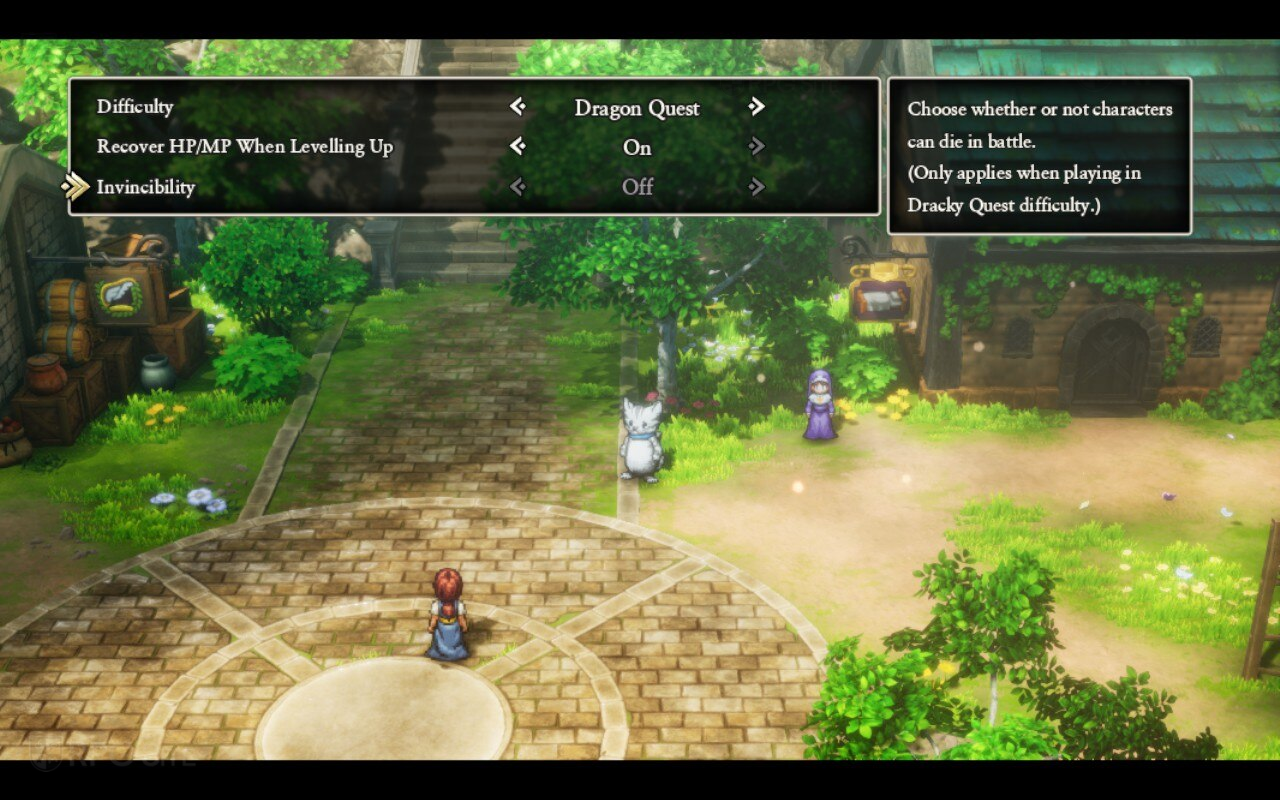

The Switch and Switch 2 both have versions of Dragon Quest I & II HD-2D Remake. Unlike Dragon Quest III, which received a free update for the Switch 2, there’s no way to transfer your save data between the Switch and Switch 2 versions of Dragon Quest I & II. If you own save data from Dragon Quest III HD-2D Remake, the Switch 2 version of Dragon Quest I & II will recognize it. Just be sure to choose the version you prefer – Switch or Switch 2 – as you won’t be able to move your progress between them.
Dragon Quest I & II HD-2D Remake visuals and performance differences across PS5, Xbox, Switch 2, PC, and Switch
The way Dragon Quest I & II HD-2D Remake works across different consoles is similar to Dragon Quest III HD-2D Remake. I was particularly interested in seeing how it performed on both the Switch and the new Switch 2. While the Switch version of Dragon Quest III received an upgrade for the Switch 2, Dragon Quest I & II was built specifically for the Switch 2 from the start.
The HD-2D Remake of Dragon Quest I & II, developed by Ardtink, runs at up to 60fps on all platforms, including PC. However, it’s limited to a 16:9 aspect ratio. This means it doesn’t natively support the wider 16:10 resolution often used by Steam Deck and taller monitors, or ultrawide resolutions like 21:9 and 32:9. Additionally, it doesn’t support a 120fps refresh rate, which some other HD-2D games do. If you want to remove these limitations, you’ll need to use a mod.
Now that’s covered, let’s talk about the Nintendo Switch version. Dragon Quest I & II HD-2D Remake runs at a maximum of 30 frames per second on Switch, whether it’s docked or played handheld. Unlike other platforms, there are no settings to adjust the graphics or performance. Loading times are also quite long, especially on the original Switch model. Even on the newer Switch, the game remains limited to 30fps and the same visual quality. This results in a somewhat blurry image, particularly on larger screens like 1440p or 4K displays. However, the newer Switch does improve performance in busy areas thanks to backward compatibility. Don’t anticipate a free update to fix these issues, as was done with Dragon Quest III HD-2 Remake.
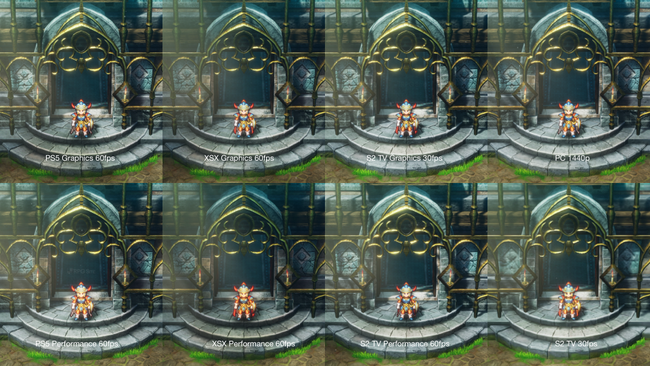
The Switch 2 version of Dragon Quest I & II HD-2D Remake lets you choose between two graphics modes: 30fps with sharper visuals, or 60fps with slightly softer visuals. While I’d hoped the Switch 2 version would be a significant improvement over the free update for Dragon Quest III HD-2D Remake, it’s quite similar. However, it’s still a major step up from playing the original Switch version. When played on the Switch 2’s screen in handheld mode, the 30fps mode looks fantastic. The 60fps mode feels smoother, but the graphics aren’t as clear, and I don’t think the HD-2D style looks good when upscaled or running at a lower resolution.
Similar to Dragon Quest III HD-2D Remake, the PS5 and Xbox Series X versions of Dragon Quest I & II HD-2D Remake offer a choice between graphics and performance modes. On the Switch 2, these modes aim for either 30 or 60 frames per second, but on PS5 and Xbox Series X, both modes target 60fps – there’s no option to play at 30fps. In my testing, the game maintained a steady frame rate, and it’s likely the performance mode exists to address the rare instances where the PS5 and Xbox versions might drop below 60fps, just like in Dragon Quest III. However, I wouldn’t recommend using performance mode on PS5 or Xbox Series X. The graphics appear noticeably blurrier, especially on a 1440p monitor, and the quality mode already delivers a smooth 60fps with sharp visuals, making performance mode feel unnecessary.
Square Enix could improve performance by letting the game automatically adjust the resolution only when necessary, since it’s otherwise running very smoothly. Currently, the two graphics modes are similar enough in frame rate but differ significantly in resolution, which might be confusing for players.
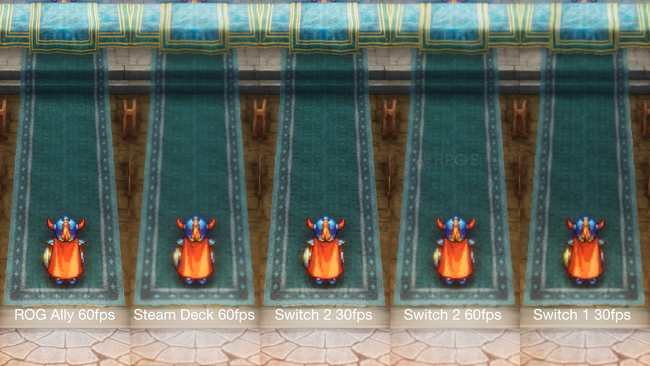
Let’s talk about how Dragon Quest I & II HD-2D Remake looks and plays on handheld devices. On the original Switch, the graphics are noticeably blurry. The Switch 2 version improves this quite a bit, especially in performance mode. If you were happy with how Dragon Quest III HD-2D Remake looked on the original Switch, you won’t see a huge difference here. It would be great if Square Enix allowed players to upgrade or transfer their save data to the Switch 2 for a better experience. Currently, the clearest handheld experience is on the ROG Ally or Steam Deck OLED. If you’re fine with a 30 frames per second rate, the Switch 2 version is good, but for smoother 60fps gameplay, I recommend the Steam Deck or ROG Ally.

The PC version of the game stands out because you can turn off the depth of field effect, something the console versions don’t allow. While this effect contributes to the game’s style, having more options is always a plus. The PC version also benefits from mod support, allowing for enhancements beyond what the consoles offer. Some mods created for the previous game, Dragon Quest III HD-2D Remake, already work with Dragon Quest I & II HD-2D Remake (like DQ3Fix), but it’s best to wait for updates specifically tested on this new version. Currently, using a mod to play in ultrawide format looks fantastic, as you can see in the image below.
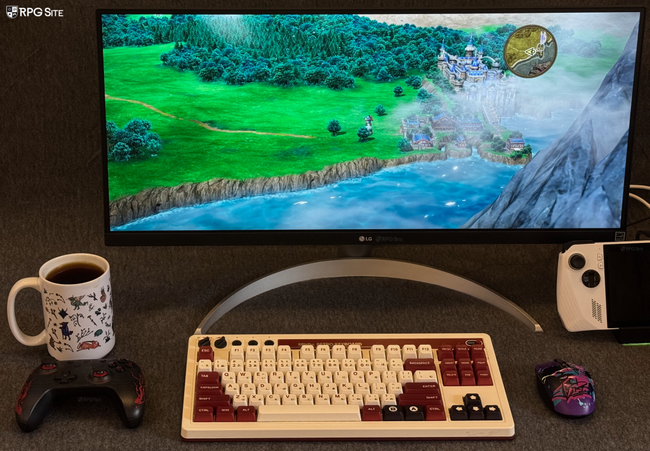
Dragon Quest I & II HD-2D Remake load times across Switch 2, PS5, Steam, Xbox, Xbox on PC, and Switch
I tested how quickly games loaded on several different systems. I used Dragon Quest I & II HD-2D Remake on a PlayStation 5, Xbox Series X, ROG Ally (both Xbox and Steam versions), Steam Deck, and Nintendo Switch 2. I also tested the Switch version of the game on an SD card using my Switch OLED.
I checked how quickly the game loaded in several situations: starting from the dashboard, loading a saved game, traveling between towns, and entering a battle in Dragon Quest I HD-2D Remake. I noticed the Xbox version has a strange 3-5 second delay when simply getting to the game selection screen after the main title screen. Hopefully, a future update will resolve this, as the Switch version doesn’t have this issue.
| Platform and test | Dashboard to title | Load save | In and out of town | Battle |
| Switch | 53 | 9-10 | 4.5 and 5 | 1 to 1.5 |
| Switch on Switch 2 | 22 | 3.5 | 3 both | 0.5 |
| Switch 2 | 20 | 4 | 3.5 both | 0.5 to 1 |
| PS5 | 7-8 | 2.5 | 2.5 both | 1 |
| Xbox Series X | 28 | 2 to 2.5 | 2.5 both | 1 |
| ROG Ally Xbox App | 34-38 | 2.5 | 2.5 both | 1 to 1.5 |
| ROG Ally Steam | 12 | 2 to 2.5 | 2 both | 1 |
| Steam Deck | 25-28 | 2.5 | 2.5 both | 0.5 to 1 |
Just a reminder: all the loading times mentioned are measured in seconds. Loading save files on the Xbox versions (both on PC and Xbox Series X) isn’t as fast or reliable as with Steam. While sometimes it loaded quickly, it usually took the amount of time, or fell within the range, I’ve noted above.
I’m glad to see the digital version of the game loads faster on the new Switch 2 console, but those improvements won’t automatically apply to the physical cartridge version. I haven’t been able to test the physical version myself. Across all other platforms, loading times are generally good, with the PlayStation 5 having the quickest start-up. The Steam version on the ROG Ally performs as well as, or even better than, the PS5. I’m frustrated that the Xbox version on PC still takes much longer to load than the Steam version on the ROG Ally, even with the same settings. Microsoft also needs to improve how saves are synced between devices. Switching between my Steam Deck and ROG Ally is seamless thanks to Steam Cloud, but the Xbox versions – on both PC and console – are noticeably slower to load and sync save data.
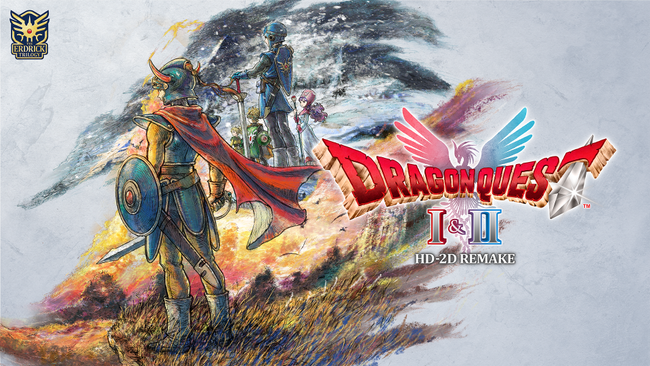
Which version of Dragon Quest I & II HD-2D Remake is the best?
Let’s look at the best ways to play this game. If you’re playing on a TV or monitor at home, the PC and PlayStation 5 versions offer the best experience, with faster loading, better graphics, and smoother performance. While the Switch 2 has a quality mode, it doesn’t quite match the visual quality of the PS5, Xbox, or PC. If you have a 1440p monitor and don’t mind playing at 30 frames per second, the Switch 2’s graphics mode is decent, but I still recommend the PC or PS5 if you have them and plan to play on a large screen at home.
When playing on the go, the best option depends on whether you prefer 60 or 30 frames per second. If you’re okay with 30fps, I think the Switch 2 looks best, especially on its larger screen. However, if you want smoother 60fps gameplay, the Switch 2 doesn’t quite measure up to the Steam Deck OLED and ROG Ally. Right now, the Steam Deck OLED provides the best 60fps portable experience, followed closely by the ROG Ally. The ROG Ally can also do 60fps at 1080p, but its screen isn’t as good as the Steam Deck OLED’s.
If you’re looking for a single device to play games both on your TV and while traveling, the Switch 2 offers the smoothest experience, surpassing the Steam Deck in that regard. While Xbox Series X/S users with a ROG Ally or PC gamers with a Steam Deck can achieve a similar TV and portable setup, the Switch 2 integrates it all into one. Syncing between devices is better with Steam than Xbox’s Play Anywhere feature. And if you primarily play games at 30 frames per second, the Switch 2 becomes an even more straightforward choice.
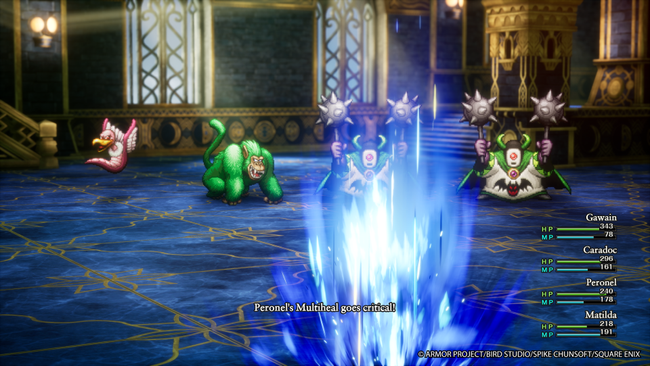
Which version of Dragon Quest I & II HD-2D Remake should you buy today?
Just a reminder: if you have save data from Dragon Quest III HD-2D Remake on the same platform (including the Switch version of DQ3 Remake if you’re playing on the new Switch 2), you’ll get a bonus! I’ve tested all versions, including the Switch version on the Switch 2, and I’m happy to report that all platforms offer a solid experience with no significant problems. However, I was hoping the native Switch 2 version of Dragon Quest I & II HD-2D Remake would perform better than the updated Switch version of Dragon Quest III HD-2D Remake running on the Switch 2. Here are my thoughts on Dragon Quest I & II HD-2D Remake for each platform:
- Dragon Quest I & II HD-2D Remake on Switch: The Switch version of Dragon Quest I & II HD-2D Remake is basically the worst version of the game technically. It is a decent way to play the game if you don’t have a Switch 2 or PC handheld and want to play on the go though. If you were fine with how Dragon Quest III HD-2D Remake looked and ran on Switch 2, you will not be bothered with how Dragon Quest I & II HD-2D Remake looks and feels. Keep in mind it is still going to have sub native visuals and performance issues. I don’t recommend playing it here if you have another option.
- Dragon Quest I & II HD-2D Remake on Switch 2: Dragon Quest I & II HD-2D Remake on Switch 2 is very similar to how Dragon Quest III HD-2D Remake felt after its enhancement patch. It features 30fps and 60fps target modes both docked and handheld and offers a good hybrid experience. I also think the Switch 2 portable experience at 30fps is excellent with how the game looks on the screen. For TV or docked play, you have better options on the other consoles, but the hybrid nature of the Switch 2 is definitely worth considering, especially if you use the 30fps mode.
- Dragon Quest I & II HD-2D Remake on Steam: If you play on Steam Deck or PC in general, this is the only version you should consider. It plays fantastic on Steam Deck out of the box at 60fps, looks amazing on the OLED screen, and lets you scale up if you also play on your main PC or docked on Steam Deck. I just wish it wasn’t capped to 60fps like other Artdink HD-2D releases. Hopefully we see some mods get updated and tested for this soon.
- Dragon Quest I & II HD-2D Remake on PS5: If you want to play on your TV, care about trophy support, and don’t care about portable play (unless you stream to a PlayStation Portal or phone which is not a native experience), this is the version of Dragon Quest I & II HD-2D Remake to get. The load times definitely make this feel snappier and quicker to get into compared to other console platforms.
- Dragon Quest I & II HD-2D Remake on Xbox: If you have access to a PC handheld or play on Xbox Series consoles and Windows 11, the Play Anywhere feature is a big selling point in addition to the Quick Resume feature on Xbox for Dragon Quest I & II HD-2D Remake. The only real issue with this version is the load times and initial syncing taking longer than other versions right now.
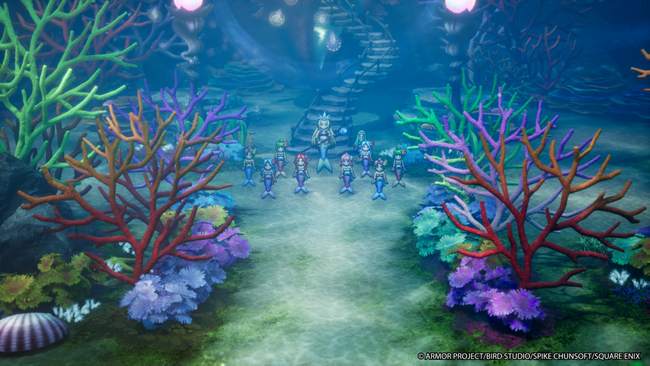
Hopefully, this comparison has helped you choose the best platform to play Dragon Quest I & II HD-2D Remake if you have options. If you’re playing on a single platform, I hope it gave you a good idea of what to expect. If you haven’t bought the game yet, it’s best to play Dragon Quest III HD-2D Remake before starting with Dragon Quest I & II.
The HD-2D Remake of Dragon Quest I & II is now available on PlayStation 5, Xbox Series X|S, Nintendo Switch, Nintendo Switch 2, and PC (via Steam and Xbox on PC). We’ve created a collection of guides to help you through the game, including full walkthroughs for both Dragon Quest I and Dragon Quest II, locations of all Mini Medals and Scrolls, and more – you can find everything here.
Read More
- Super Animal Royale: All Mole Transportation Network Locations Guide
- bbno$ speaks out after ‘retirement’ from music over internet negativity
- The best Five Nights at Freddy’s 2 Easter egg solves a decade old mystery
- ‘M3GAN’ Spin-off ‘SOULM8TE’ Dropped From Release Calendar
- Gold Rate Forecast
- Brent Oil Forecast
- Avengers: Doomsday Trailer Leak Has Made Its Way Online
- Zerowake GATES : BL RPG Tier List (November 2025)
- Spider-Man 4 Trailer Leaks Online, Sony Takes Action
- Katanire’s Yae Miko Cosplay: Genshin Impact Masterpiece
2025-11-03 11:00